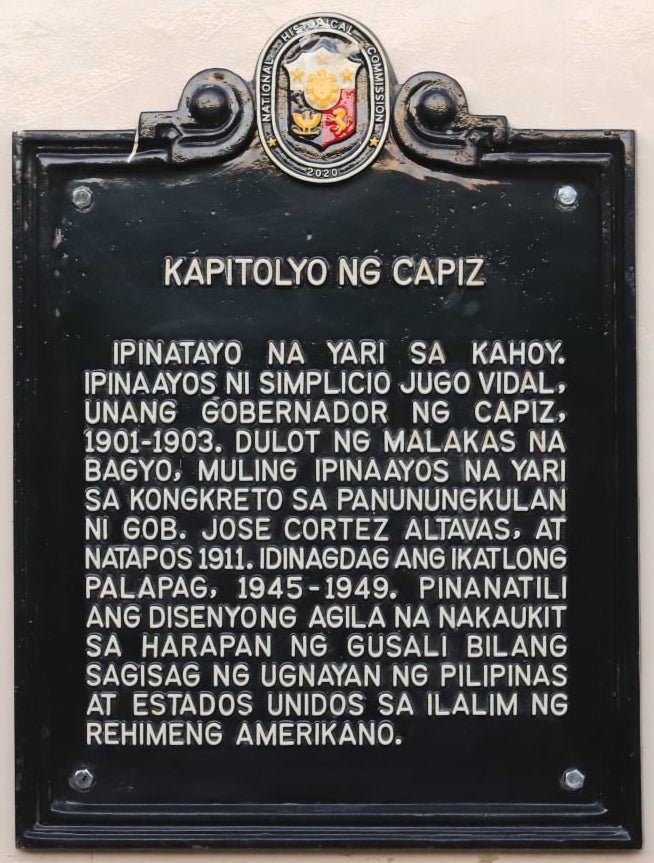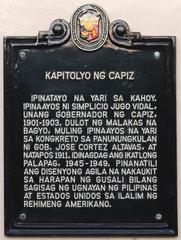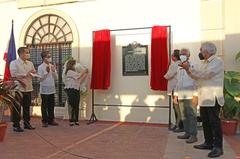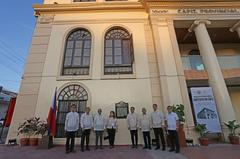
Capitol of Capiz Historical Marker Roxas City: Visiting Hours, Tickets, and Travel Guide
Date: 14/06/2025
Introduction
The Capitol of Capiz Historical Marker, prominently located in the heart of Roxas City—the capital of Capiz province—stands as a testament to the city’s rich political, cultural, and architectural heritage. Roxas City, renowned as the “Seafood Capital of the Philippines,” offers visitors a unique blend of historical landmarks, colonial architecture, and vibrant cultural traditions (capiz-online.com; philippinescities.com). The Capiz Provincial Capitol, a neoclassical building constructed during the American colonial era, is both a symbol of local governance and a focal point for community life (mb.com.ph; capisnon.com).
This guide provides a comprehensive overview of the Capitol of Capiz Historical Marker, its significance, visiting information, nearby attractions, accessibility, and practical travel tips. Whether you are a history enthusiast, culture seeker, or first-time visitor to Roxas City, this resource will help you plan an enriching and memorable experience.
Table of Contents
- Early History and Colonial Foundations
- Capiz as a Colonial and Economic Center
- American Period and World War II
- Postwar Developments and Cityhood
- Capiz Provincial Capitol: Architectural Features and Preservation
- The Capitol Historical Marker: Significance and Project Mohon
- Visitor Information: Hours, Tickets, and Accessibility
- Guided Tours and Heritage Walks
- Nearby Attractions and Cultural Landmarks
- Practical Travel Tips
- Frequently Asked Questions (FAQ)
- Conclusion and Call to Action
- References
Early History and Colonial Foundations
The area now known as Roxas City has a history that predates Spanish colonization, with Austronesian and Malay settlers establishing early communities along its rivers (capiz-online.com). Spanish explorers arrived in the 16th century, making Panay Island the second Spanish settlement in the Philippines. The town of Pan-ay initially served as the provincial capital before it was moved to Capiz (now Roxas City) due to its strategic coastal location (philippinescities.com).
Capiz as a Colonial and Economic Center
By the late 1500s, Capiz was an important port in the Manila-Acapulco Galleon Trade, fostering economic growth and the rise of a mestizo principalia class (philippinescities.com). The city’s development included the extension of major streets and the construction of stone forts at Baybay Beach to defend against raiders.
American Period and World War II
Capiz became a civil province under American rule in 1901 (capiz-online.com). The Capiz National High School opened in 1902 (pia.gov.ph), and construction of the Capiz Provincial Capitol began in 1911 (capisnon.com). During World War II, the city endured Japanese occupation until its liberation in 1945.
Postwar Developments and Cityhood
Roxas City was officially established in 1951, named in honor of President Manuel Roxas, a native son of Capiz (philippinescities.com). The city has grown as a regional center for commerce, culture, and governance.
Capiz Provincial Capitol: Architectural Features and Preservation
Neoclassical Legacy
The Capiz Provincial Capitol exemplifies neoclassical architectural design, featuring imposing columns, a symmetrical façade, and a grand portico (mb.com.ph; vymaps.com). Designed by William Parsons, it was completed in the early 20th century during the American colonial period. The Capitol’s whitewashed exterior, broad steps, and expansive gardens create a sense of openness and dignity.
Site and Heritage Zone
Strategically located in the city’s heritage district, the Capitol is surrounded by the Immaculate Conception Metropolitan Cathedral, Roxas City Fountain, and Capiz Bridge (7641islands.ph). The Capitol complex also includes the Hall of Governors and serves as a venue for community events, festivals, and cultural performances (thecapiztimes.com).
Preservation Efforts
Restoration and maintenance have preserved the Capitol’s neoclassical charm. The unveiling of its historical marker by the National Historical Commission of the Philippines (NHCP) in 2022 underscores ongoing efforts to safeguard Capiz’s architectural heritage (mb.com.ph).
The Capitol Historical Marker: Significance and Project Mohon
The Capitol of Capiz Historical Marker, installed as part of Project Mohon, commemorates the site’s importance in local governance and Capiz’s identity (PIA Capiz). Project Mohon aims to install markers at significant sites throughout the province to foster pride in Capiznon heritage.
The marker outlines the Capitol’s historical development, architectural features, and enduring role as a symbol of unity and progress. The Capitol grounds have hosted pivotal events such as political rallies, independence celebrations, and cultural festivals—making it a living monument for Capiznons.
Visitor Information: Hours, Tickets, and Accessibility
- Visiting Hours: The Capitol grounds and historical marker are open to the public from 8:00 AM to 5:00 PM, Monday through Friday. The city plaza area surrounding the marker is accessible daily from 6:00 AM to 9:00 PM (HopnCruise).
- Tickets: Admission to the Capitol grounds and marker is free. Some nearby museums may charge a modest fee (PHP 20–50).
- Accessibility: The Capitol and plaza areas are wheelchair accessible, with ramps and wide walkways. Public restrooms are available during office hours.
- Guided Tours: Heritage walks and guided tours featuring the Capitol marker are offered by local tourism offices and private operators (Guide to the Philippines).
Guided Tours and Heritage Walks
The Capitol is a prominent stop on Roxas City’s heritage walk tours, which include the ancestral house of President Manuel Roxas, Immaculate Conception Cathedral, Panublion Museum, and other city landmarks (Espacio Verde Resort). Guided tours provide historical context and anecdotes, enriching the visitor experience.
Nearby Attractions and Cultural Landmarks
- Immaculate Conception Metropolitan Cathedral: One of Panay’s oldest churches, noted for its Gothic architecture.
- Panublion Museum: Housed in a former water tank, the museum features artifacts and memorabilia on Capiz history.
- Roxas City Fountain and Plaza: The city’s kilometer zero and a vibrant gathering place.
- Jose Rizal Monument and Bandstand: Key sites for civic events and local festivities.
- Ancestral House of President Manuel Roxas: The birthplace of the fifth President of the Philippines (The Happy Trip).
These attractions are all within walking distance, making Roxas City’s historic core ideal for leisurely exploration (Travel Philippines Idea).
Practical Travel Tips
- Best Time to Visit: November to May (dry season) is ideal. December’s Sinadya sa Halaran Festival offers a unique cultural experience.
- Dress Code: Dress modestly, especially when entering government offices or churches.
- Local Transport: Tricycles and jeepneys are readily available. Roxas Airport is 15 minutes by tricycle or taxi from the city center.
- Dining: Enjoy fresh seafood at Baybay Beach or local restaurants near the Capitol (The Happy Trip).
- Safety: The Capitol area and city plaza are generally safe, with regular security presence.
Frequently Asked Questions (FAQ)
Q: What are the visiting hours for the Capitol of Capiz Historical Marker?
A: The marker and plaza are open daily from 6:00 AM to 9:00 PM; the Capitol grounds are accessible from 8:00 AM to 5:00 PM, Monday to Friday.
Q: Is there an entrance fee?
A: No, access to the Capitol marker and plaza is free.
Q: Are guided tours available?
A: Yes, guided heritage walks are offered by local tourism offices and private operators.
Q: Is the site accessible for visitors with disabilities?
A: Yes, the plaza and Capitol grounds have ramps and wide walkways.
Q: What other attractions are nearby?
A: Immaculate Conception Cathedral, Panublion Museum, Roxas City Fountain, Rizal Monument, and President Roxas’s ancestral house.
Q: When is the best time to visit?
A: Visit during the dry season or when festivals like Sinadya sa Halaran are held for a livelier experience.
Conclusion and Call to Action
The Capitol of Capiz Historical Marker is a vital touchstone in Roxas City’s historical and cultural landscape. Free and easily accessible, it invites visitors to connect with the province’s legacy, experience its neoclassical architectural grandeur, and participate in ongoing community life. Surrounded by significant landmarks, lively plazas, and welcoming locals, it is a must-visit for travelers eager to immerse themselves in the region’s past and present.
Maximize your Capiz adventure by planning your visit during festivals or joining a guided heritage walk. For tailored itineraries, insider tips, and real-time updates, download the Audiala app and follow Roxas City tourism channels online.
[Explore related articles: Roxas City Heritage Walk, Panublion Museum Highlights, Sinadya sa Halaran Festival Guide]
References
- Maragtas sang Capiz: Short Summary of the History of Capiz, 2020, Capiz Online
- Roxas City, Capiz, Philippines Cities, 2023
- Historical marker for Capiz Provincial Capitol unveiled, 2022, Manila Bulletin
- The Construction of Capiz Provincial Capitol, 2020, Capisnon
- Marking history: The legacy behind Capiz NHS Gabaldon Building, 2023, PIA
- Capiz Unveils Siege of Panay Historical Marker, 2023, PIA Capiz
- Roxas City: A Living Heritage of Centuries Past, 2024, Capiz Online
- Capture Capiz: Rich Cultural Heritage and Gastronomic Haven Rolled into One, 2024, 7641 Islands
- Capiztahan: A Glimpse Through the Years, 2023, The Capiz Times
- Roxas City Travel Guide, Itinerary, Budget, Cheap Hotels, 2018, The Happy Trip
- Discover Roxas City’s Historic District with a Heritage Walk Tour, 2024, Espacio Verde Resort
- The Most Amazing Tourist Spot of Roxas City, 2024, Travel Philippines Idea
- Ilonggo Notes: Heritage Walk Roxas City Capiz, 2023, Rappler
- History of Roxas City Capiz, 2022, Scribd
- HopnCruise: Roxas Tourist Spots
- Guide to the Philippines: Roxas Tours


